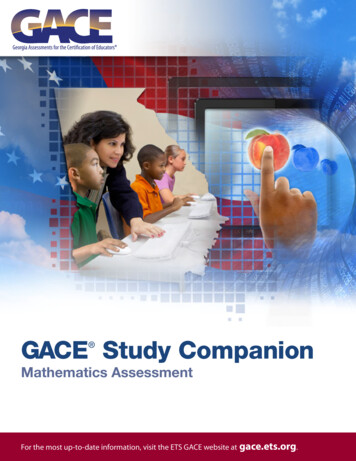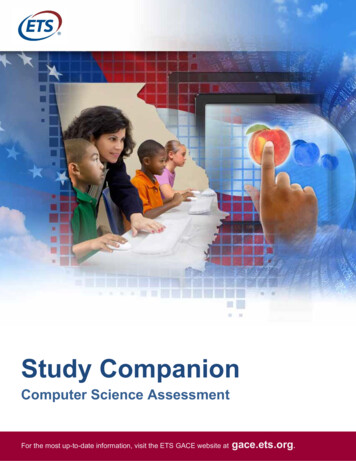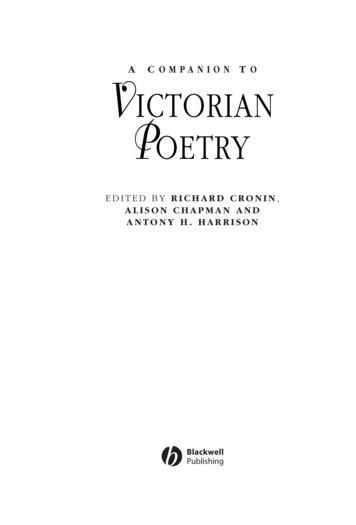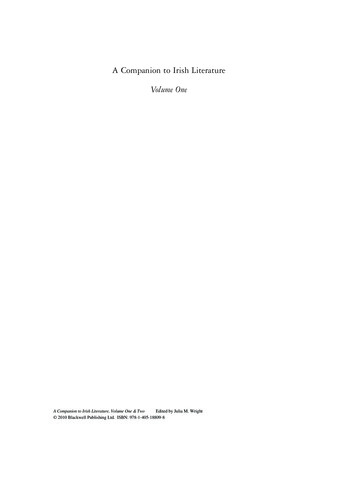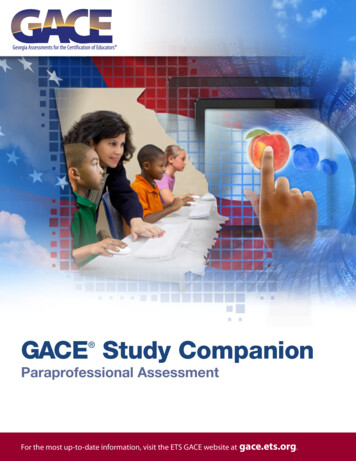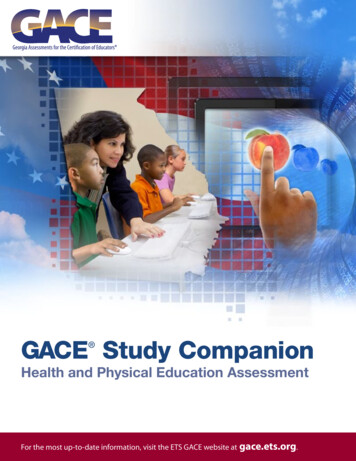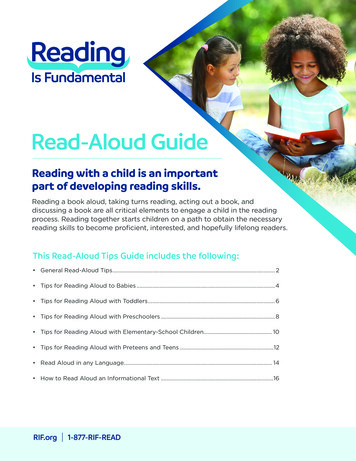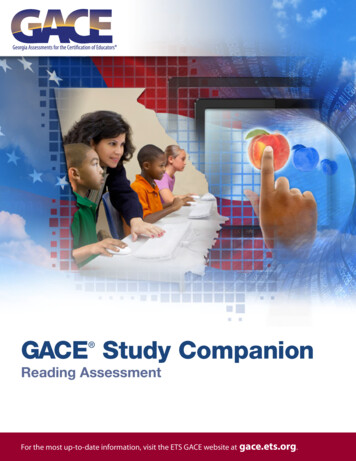
Transcription
GACE Study Companion Reading AssessmentFor the most up-to-date information, visit the ETS GACE website at gace.ets.org.
Last Updated: January 2017Copyright 2017 by Educational Testing Service. All rights reserved. ETS is a registeredtrademark of Educational Testing Service (ETS). Georgia Assessments for the Certification ofEducators, GACE, and the GACE logo are registered trademarks of the Georgia ProfessionalStandards Commission (GaPSC). All other trademarks are property of their respective owners.This publication has been produced for the GaPSC by ETS. ETS is under contract to theGaPSC to administer the Georgia Assessments for the Certification of Educators. TheGeorgia Assessments for the Certification of Educators are administered under the authorityof the GaPSC; regulations and standards governing the program are subject to change withoutnotice at the discretion of the GaPSC. The GaPSC and ETS are committed to preventingdiscrimination on the basis of race, color, national origin, sex, religion, age, or disability in theadministration of the testing program or the provision of related services.
Table of ContentsAbout the Assessment . 4Content Specifications . 5Test I Subareas . 6Test I Objectives . 6Subarea I: Curriculum and Instruction . 6Subarea II: Professional Learning and Leadership . 7Test II Subareas . 8Test II Objectives . 8Subarea I: Assessment and Evaluation . 8Subarea II: Diversity and Literate Environment . 9Practice Questions .10Answer Key and Rationales .23Preparation Resources .31Guide to Taking a GACE Computer-delivered Assessment .31Reducing Test Anxiety.31Study Tips: Preparing for a GACE Assessment .31Journals.31Other Resources .31Online Resources .35Note: After clicking on a link, right click and select “Previous View” to go back to original text.GACE Reading Assessment Study Companion3
About the AssessmentAssessment NameReadingGrade LevelP–12Test CodeTest I: 117Test II: 118Combined Test I and Test II: 617Testing TimeTest I: 2 hoursTest II: 2 hoursCombined Test I and Test II: 4 hoursTest DurationTest I: 2.5 hoursTest II: 2.5 hoursCombined Test I and Test II: 5 hoursTest FormatComputer deliveredNumber of Selected-response QuestionsTest I: 80Test II: 80Combined Test I and Test II: 160Question FormatThe test consists of a variety of short-answerquestions such as selected-responsequestions, where you select one answerchoice or multiple answer choices (dependingon what the question asks for), questionswhere you enter your answer in a text box,and other types of questions. You can reviewthe possible question types in the Guide toTaking a GACE Computer-delivered Test.Number of Constructed-response QuestionsTest I: 0Test II: 0Combined Test I and Test II: 0The GACE Reading assessment is designed to measure the professional knowledge ofprospective Reading teachers in the state of Georgia.Note: After clicking on a link, right click and select “Previous View” to go back to original text.GACE Reading Assessment Study Companion4
This assessment includes two tests. You may take either test individually or the full assessmentin a single session. The testing time is the amount of time you will have to answer the questionson the test. Test duration includes time for tutorials and directional screens that may be includedin the test. This test includes listening items; an ETS-approved headset will be provided at thetest center.The questions in this assessment assess both basic knowledge across content areas and theability to apply principles.The total number of questions that are scored is typically smaller than the total number ofquestions on the test. Most tests that contain selected-response questions also includeembedded pretest questions, which are not used in calculating your score. By including pretestquestions in the assessment, ETS is able to analyze actual test-taker performance on proposednew questions and determine whether they should be included in future versions of the test.Content SpecificationsEach test in this assessment is organized into content subareas. Each subarea is furtherdefined by a set of objectives and their knowledge statements. The objectives broadly define what an entry-level educator in this field in Georgia publicschools should know and be able to do. The knowledge statements describe in greater detail the knowledge and skills eligible fortesting. Some tests also include content material at the evidence level. This content serves asdescriptors of what each knowledge statement encompasses.See a breakdown of the subareas and objectives for the tests in this assessment on thefollowing pages.Note: After clicking on a link, right click and select “Previous View” to go back to original text.GACE Reading Assessment Study Companion5
Test I SubareasSubareaApprox. Percentageof TestI. Curriculum and Instruction*70%II. Professional Learning and Leadership30%* This subarea includes one or more questions that contain recorded audio information.Test I ObjectivesSubarea I: Curriculum and InstructionObjective 1: Understands foundational knowledge relating to literacy acquisition and readingdevelopmentThe beginning Reading teacher:A. Recognizes and applies foundational theories of reading and writing processes; e.g.,behaviorism, cognitivism, constructivismB. Demonstrates knowledge of first- and second-literacy acquisition and the role of nativelanguage in learning to read and write in a second languageC. Explains the research that supports effective learning environments and the role theyplay in motivating students to read and writeD. Uses multiple sources of information to guide instructional planning to improve readingachievement of all studentsE. Selects and implements reading and writing approaches that are research-based andmeet student needsF. Demonstrates knowledge about various materials and their uses to promote higher orderthinking, interpretation, argumentation, and making text connectionsObjective 2: Demonstrates an understanding of curriculum and instructional approaches in thereading classroomThe beginning Reading teacher:A. Implements the curriculum based on students’ prior knowledge, real-world experiences,and interestsB. Evaluates the curriculum to ensure that instructional goals and objectives in reading andwriting are metC. Implements the curriculum through interdisciplinary connections using traditional print,digital, and online contextsD. Selects and implements reading and writing approaches that are research-based andmeet student needsNote: After clicking on a link, right click and select “Previous View” to go back to original text.GACE Reading Assessment Study Companion6
E. Describes instructional approaches to meet students’ needs in developing emergentliteracy skills; e.g., print concepts, phonological awareness, the alphabetic principleF. Describes instructional approaches to meet students’ needs in developing word-learning(word recognition) strategies; e.g., sight word recognition, phonics, context clues,syllabication, morphemic analysis, structural analysis, etymology, cognate awareness,use of word reference materialsG. Describes instructional approaches to meet students’ reading and writing needs inlearning vocabulary, including academic and domain-specific words or phrasesH. Describes instructional approaches to meet students’ reading and writing needs incomprehension, including literary and informational textsI.Describes instructional approaches to meet students’ reading and writing needsin fluencyJ. Describes instructional approaches to meet students’ needs in writingK. Adapts instructional approaches and materials to meet the language-proficiency needsof English-language learnersL. Knows a variety of instructional approaches for developing students’ listening andspeaking skillsM. Demonstrates knowledge of selecting diverse literary and informational materials in avariety of genres at varying text complexity levels from traditional print, digital, andonline resourcesSubarea II: Professional Learning and LeadershipObjective 1: Understands the relationship between literacy leadership and literacy developmentThe beginning Reading teacher:A. Displays and models positive reading and writing behaviorsB. Understands the roles that diverse families and communities play in helping studentsdevelop and apply literacy skillsC. Works with families, colleagues, and the community to support student learningD. Promotes student understanding of the value of reading traditional print, digital, andonline resources in and out of schoolE. Demonstrates effective use of technology for improving student learningF. Recognizes the importance of professional development for improving reading andwriting in schoolNote: After clicking on a link, right click and select “Previous View” to go back to original text.GACE Reading Assessment Study Companion7
Test II SubareasSubareaApprox. Percentageof TestI. Assessment and Evaluation*50%II. Diversity and Literate Environment50%* This subarea includes one or more questions that contain recorded audio information.Test II ObjectivesSubarea I: Assessment and EvaluationObjective 1: Understands how to gather and use student data to promote reading developmentThe beginning Reading teacher:A. Demonstrates an understanding of established purposes for assessing studentperformance, including tools for screening, diagnosis, progress monitoring, andmeasuring outcomesB. Describes strengths and limitations of assessment tools and their appropriate usesC. Recognizes the basic technical adequacy of assessments; e.g., reliability, content, andconstruct validityD. Selects or develops assessment tools to monitor student progress and to analyzeinstructional effectivenessE. Selects and develops classroom assessments using consistent, fair, and equitableassessment proceduresF. Interprets and uses assessment data to analyze individual, group, and classroomperformance and progressG. Collaborates with other teachers and support personnel to discuss interpretation ofassessment data and their uses in responding to student needs and strengthsH. Uses assessment data to evaluate students’ responses to instruction, to adjustinstruction, and to develop relevant next steps for teachingI.Identifies and interprets patterns in classroom and individual student’s dataJ. Recognizes the importance of collaborating with other reading professionals to modifyinstruction and to plan and evaluate interventions based on assessment dataNote: After clicking on a link, right click and select “Previous View” to go back to original text.GACE Reading Assessment Study Companion8
Subarea II: Diversity and Literate EnvironmentObjective 1: Demonstrates an understanding of how to meet the needs of diverse learnersThe beginning Reading teacher:A. Demonstrates an understanding of the ways in which diversity can be used to strengthena literate society, making it more productive, more adaptable to change, and moreequitableB. Demonstrates an understanding of the ways in which different forms of diversityinfluence reading and writing developmentC. Uses a literacy curriculum and engages in instructional practices that positively impactstudents’ knowledge, beliefs, and engagement with the features of diversityD. Assesses the various forms of diversity that exist in the school and in the surroundingcommunityE. Provides differentiated instruction and instructional materials, including traditional print,digital, and online resources that capitalize on diversityF. Provides instructional formats that engage students as agents of their own learningG. Demonstrates an understanding of various perspectives of literacy and how differentpolicies and different perspectives affect literacyH. Demonstrates a respectful attitude toward all learners and understands the roles ofchoice, motivation, and scaffolded support in creating positive social environmentsI.Creates supportive environments where English-language learners are encouraged andgiven many opportunities to use EnglishJ. Uses various practices to differentiate instruction; e.g., flexible grouping, cooperativelearning, literature circles, partner work, and research/investigation groupsNote: After clicking on a link, right click and select “Previous View” to go back to original text.GACE Reading Assessment Study Companion9
Practice QuestionsThe practice questions in this study companion are designed to familiarize you with the typesof questions you may see on the assessment. While they illustrate some of the formats andtypes of questions you will see on the test, your performance on these sample questions shouldnot be viewed as a predictor of your performance on the actual test. Fundamentally, the mostimportant component in ensuring your success is familiarity with the content that is covered onthe assessment.To respond to a practice question, choose one of the answer options listed. Be sure to readthe directions carefully to ensure that you know what is required for each question. You may findit helpful to time yourself to simulate actual testing conditions. A correct answer and a rationalefor each sample test question are in the section following the practice questions.Keep in mind that the test you take at an actual administration will have different questions,although the proportion of questions in each subarea will be approximately the same. Youshould not expect the percentage of questions you answer correctly in these practice questionsto be exactly the same as when you take the test at an actual administration, since numerousfactors affect a person’s performance in any given testing situation.Note: After clicking on a link, right click and select “Previous View” to go back to original text.GACE Reading Assessment Study Companion10
Directions: Each of the questions or incomplete statements below is followed by four suggestedanswers or completions. Select the one that is best in each case.1.A school is planning to use the Response to Intervention (RTI) model to address students’literacy needs. Which of the following best represents a way the school can effectivelyengage and sustain the involvement of families in the RTI process?A. Inviting parents to attend an RTI literacy night before implementing the processB. Providing informational pamphlets about RTI for families to read at homeC. Forming a committee made of parents and teachers to advocate for studentsreceiving RTID. Collaborating and partnering with families during all phases of RTIAnswer and Rationale2.A kindergarten teacher uses sound boxes, picture cards, and disk markers like the onesshown. The teacher models how to use the cards by slowly articulating each word whilemoving tiles up into the boxes for each distinct sound. Students are then asked to move amarker into the box representing the part of the word with the /t/ sound.This activity best promotes the development ofA.B.C.D.syllabication.phonemic awareness.the alphabetic principle.onset and rime identification.Answer and RationaleNote: After clicking on a link, right click and select “Previous View” to go back to original text.GACE Reading Assessment Study Companion11
3.Which of the following statements most accurately identifies best practice inliterature selection?A. Reading selections should reflect the values, beliefs, and cultural experiences of thestudents’ parents.B. Reading selections should consider all viewpoints, respect differences, and help studentsto become more self-aware.C. Students gain an appreciation for different types of literature by reading the main typesof genres presented in textbooks.D. Students should primarily be exposed to literature from their own country of origin tohelp them learn more about the country’s history.Answer and Rationale4.A teacher reads a story about a basketball game to students, pausing at different points in thestory to model thinking about the events and feelings of the main character. Below are theteacher’s reactions, stated aloud to students, while reading part of the text.Text:Amanda slowly dribbled the ball, dreading the moment when she wouldhave to take the shot. She remembered the last time she stood on the line.Teacher: Amanda must feel very nervous and not confident in her ability to makethe shot. I remember a time in high school when I let my hockey teamdown by missing a goal in a game. I felt really bad.Text:The game’s outcome depended upon Amanda. Last time, she failed.Teacher: The game must be nearly over, and Amanda remembers how badly shefelt in the last game, when her performance must have been the one thingthat caused the team to lose.The teacher’s objective in conducting the think-aloud is to provide direct instruction inwhich of the following reading comprehension hesizingAnswer and RationaleNote: After clicking on a link, right click and select “Previous View” to go back to original text.GACE Reading Assessment Study Companion12
5.A third-grade teacher asks students to use a graphic organizer to record predictions about astory before they read the text. The teacher instructs the students to confirm or adjust theirpredictions as necessary as they read the story. The teacher’s most likely objective in usingthe activity is which of the following?A.B.C.D.To ensure that students monitor their comprehension as they readTo encourage students to explore cause and effect relationships while reading the textTo provide opportunities for students to make text-to-text connections as they readTo have students use details while reading the text to determine the author’s purposeAnswer and Rationale6.Which of the following strategies best facilitates students’ comprehension of reading in thecontent areas and builds on prior knowledge?A. Rereading passages of the text where there are unknown words to infer meaningfrom contextB. Implementing skills-focused reading and rereading exercises during classC. Making predictions about the text and reviewing the predictions while readingD. Looking up words from the text in the glossary of the textbook or a dictionaryAnswer and RationaleNote: After clicking on a link, right click and select “Previous View” to go back to original text.GACE Reading Assessment Study Companion13
7.Which of the following is the best example of a teacher using scaffolding to supportstudents who are English-language learners?A. Having students use a dictionary to look up and record definitions of unfamiliarvocabulary before reading a textB. Encouraging the use of group reading and writing activities so students can rely onEnglish-speaking peers for helpC. Providing a graphic organizer that previews and highlights important information for areading passageD. Modifying or shortening a writing assignment that follows the reading of a selected textAnswer and Rationale8.Which of the following instructional strategies best completes the chart?A.B.C.D.ReadingComprehensionReading FluencyWritingVocabularyDirected readingthinking activityShared readingSentence combiningWord huntsInquiry chartPartner readingParagraphhamburgerPossible sentencesThink-pair-share?RevisingWord wallsSemantic feature analysisBrainstormingReaders’ theaterAnticipation guideAnswer and RationaleNote: After clicking on a link, right click and select “Previous View” to go back to original text.GACE Reading Assessment Study Companion14
9.Which of the following words has three distinct phonemes?A.B.C.D.PhonyMuckSheBrightAnswer and Rationale10. Which of the following is most important for a teacher to consider when identifyingmaterials to improve the literacy development of a group of linguistically and culturallydiverse students?A. Selecting books that use imaginary characters based on curriculum from popular cultureB. Providing resources that reflect a variety of content, styles, social views, and racialexperiencesC. Including books that have a language-translation resource for students to use at homeand in the classroomD. Choosing informational texts and literature at students’ independent reading levelAnswer and RationaleNote: After clicking on a link, right click and select “Previous View” to go back to original text.GACE Reading Assessment Study Companion15
11. Which of the following is the best way to foster a learning environment that is respectful of,and responsive to, linguistic and cultural diversity?A.B.C.D.Displaying images that portray traditional gender rolesPlaying recordings of songs performed in various languagesMaintaining limited materials in the dramatic play areaProviding puzzles that depict conventional familiesAnswer and Rationale12. A teacher makes sure that over half of the books in the classroom library are nonfiction.Which of the following is the primary purpose for including nonfiction books?A.B.C.D.Ensuring students’ ability to analyze text types found on standardized testsProviding readers with exposure to a variety of text structures and featuresGuaranteeing student mastery of grade-level content-area standardsMotivating all readers to prefer nonfiction over fiction booksAnswer and RationaleNote: After clicking on a link, right click and select “Previous View” to go back to original text.GACE Reading Assessment Study Companion16
13. Which of the following teacher actions best encourages and sustains students’ motivation toengage in literacy tasks?A. Providing students with print materials that contain easily decodable vocabularyB Offering students frequent opportunities to interact with text independently andwith peersC Having students respond to content-based comprehension questions while readingD Incorporating technology-based resources to develop students’ interest in research skillsAnswer and Rationale14. During a reading conference, a teacher notices that a student is unable to answer basiccomprehension questions about a book after reading it. Which of the following actions isbest for the teacher to take first?A.B.C.D.Preparing an outline of the plot to assist the student in recalling important detailsEncouraging the student to reread the parts of the book that were difficult to understandConducting a mini-lesson on active reading strategies the student can use while readingAdministering an informal assessment to identify the skills with which the studentis strugglingAnswer and RationaleNote: After clicking on a link, right click and select “Previous View” to go back to original text.GACE Reading Assessment Study Companion17
15. While planning the reading curriculum for the coming school year, a new teacher is lookingto develop clear expectations for instruction and assessment. Which of the following aremost important for the teacher to read?A.B.C.D.Performance standardsAssessment frameworksStudent benchmarksEducational articlesAnswer and Rationale16. The most appropriate assessment for evaluating students’ phonological awareness skills is toask students toA.B.C.D.divide words into syllables.read a list of words from a passage rapidly.identify prefixes and suffixes in words.complete a cloze activity with a list of given words.Answer and RationaleNote: After clicking on a link, right click and select “Previous View” to go back to original text.GACE Reading Assessment Study Companion18
17. A third-grade teacher is using recent assessment data to plan reading instruction. Whichof the following strategies best supports the teacher in addressing the changing needs ofall learners?A.B.C.D.Using flexible small groups to remediate and reinforce learningProgressing to more difficult texts for whole-class read-aloudsCalling each student to a table for individualized instructionPairing students with a partner to share the reading loadAnswer and Rationale18. Which of the following activities will best help to strengthen the bond between homeand school?A. Posting pertinent classroom information on the school Web siteB. Sending out frequent updates regarding current school activitiesC. Hosting a day each year when parents are invited to attend school for a portion ofthe dayD. Providing regular opportunities for parents to give input and enhance students’ learningopportunitiesAnswer and RationaleNote: After clicking on a link, right click and select “Previous View” to go back to original text.GACE Reading Assessment Study Companion19
19. For each of the following statements, indicate whether it describes an effective or ineffectiveintegration of technology into the classroom.Select all that apply. Some rows may be empty. [Note: In the actual test, you will click inthe boxes to select your answer choices.]StatementEffectiveIneffectiveA teacher creates an environment in which there is morefocus on content standards than there is on the technologybeing used.A school emphasizes the benefit of limiting the use oftechnology in the classroom.A teacher identifies students who are very comfortable usingtechnology and designates them “classroom experts.”Answer and Rationale20. Which of the following classroom activities is the most nonthreatening way to facilitatestudents’ use of formal English, particularly for English-language learners?A.B.C.D.Asking students to give a brief speech on a topic of interest to themHaving students write an essay about their family traditionsLeading a conversation in which students can build upon comments of othersReading a short passage aloud and then asking students questions about itAnswer and RationaleNote: After clicking on a link, right click and select “Previous View” to go back to original text.GACE Reading Assessment Study Companion20
21. Which of the following is the primary instructional purpose for allowing students to choosetheir reading texts?A.B.C.D.Encouraging students to take ownership of their learningImproving students’ flexibility in applying reading strategiesProviding opportunities for students to explore their interestsHelping students locate texts at their independent reading levelAnswer and Rationale22. Ms. Thompson realizes that her class is made up of students who have had a variety ofdifferent experiences and who offer differing perspectives because of their many ethnic,cultural, and linguistic groups. She wants to ensure that all students, regardless of theirbackground, are successful.For each of the following statements, indicate whether it describes an effective or ineffectivestrategy for increasing student achievement within a diverse group of students.Select all that apply. Some rows may be empty. [Note: In the actual test, you will click inthe boxes to select your answer choices.]StatementEffectiveIneffectiveMake adjustments to the standards and the level ofexpectations for students according to their background.Encourage parents and guardians to actively participate inthe students’ learning.Connect the learning taking place in the classroom with thestudents’ backgrounds.Answer and RationaleNote: After clicking on a link, right click and select “Previous View” to go back to original text.GACE Reading Assessment Study Companion21
23. During a writing workshop, Ms. Dalton, a third-grade teacher, introduces personal narrativeto the class. To model the type of writing for students, Ms. Dalton shares a piece she wroteabout her first kayaking trip. The class then discusses important elements of the personalnarrative story. Which of the following is the most appropriate next step for the teacher totake during the writing workshop?A.B.C.D.Having students write a piece independently on a self-selected topic in the same genreProviding students with opportunities to write while receiving supported practiceHaving students revise a piece of writing crafted by a teacher in a different classAsking students to write about a topic selected from a list of suggested ideasAnswer and Rationale24. Which of the following is the best reason for an English teacher to use culturally diverseliterature in the classroom?A. Representing a variety of perspectives on the human experienceB. Fulfilling requirements set forth by the school’s English curriculumC. Providing awareness of other languages by inc
The practice questions in this study companion are designed to familiarize you with the types of questions you may see on the assessment. While they illustrate some of the formats and types of questions you will see on the test, your performance on these sample questions should not be viewed as a predictor
